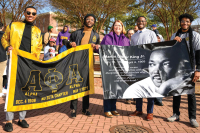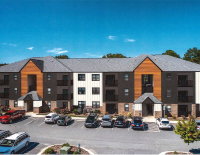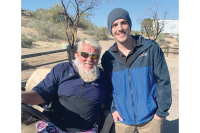Taking it to the street: Waynesville Public Art Commission seeks to promote cultural heritage with downtown art project
By Michael Beadle
What would New York City be without its Statue of Liberty? Picture St. Louis without its Gateway Arch. What would towns and cities be without their signature sculptures and eye-catching murals?
To local residents and visitors alike, public art establishes that unique sense of place, an identity, a familiar landmark that attracts people and keeps them coming back.
Over the last several years, downtown Waynesville has become home to a variety of public art pieces along its streets — from Grace Cathey’s metal sculpture garden on Depot Street to the roaring dinosaur built with car parts across from the courthouse to the playful sculptures of bears and jellyfish along Main Street.
But most of these pieces are on loan from the artists rather than owned by the town. Now with a public art commission in place, the Town of Waynesville is planning to have permanent pieces put in place.
It started in 1999 with an annual outdoors sculpture contest known as “Streetscapes.” But after funding for Streetscapes dried up, a committee formed in 2005 and later evolved into a town commission in 2006 that would study long-term plans for public art in downtown Waynesville.
Related Items
Last week, Waynesville’s Public Art Commission, led by Waynesville dentist Mike Gillespie, began looking over 17 applications from regional artists in order to select three finalists who will present their ideas to the public. Applicants have been charged with creating a piece exclusively for Waynesville that pertains to the commission’s chosen theme of old time music. The piece will be placed on the corner of the intersection of Main and Miller Streets in the heart of downtown.
The commission has set a cost of up to $20,000 to be paid for the commissioned work — an amount raised using public and private funds. So far, the Town of Waynesville has allotted the commission $9,000 in start up funds to be used for operating expenses, marketing and small stipends to the three artists selected to present their ideas for the inaugural project to the public. A special committee of local citizens and government representatives will choose among these three finalists based on the models of their work.
Community involvement
For the past two years, the public art commission has been meeting and working, charged with its mission to enrich public spaces in downtown Waynesville and engage the community with artwork that celebrates the town’s unique cultural, historic and natural resources. The commission meets regularly at 5:30 p.m. the second Thursday of each month in the Waynesville Town Hall, and meetings are open to the public.
According to Gillespie, the process for selecting this first artist will involve a special selection committee that will include about 20 to 25 local residents representing a cross-section of the community — business leaders, county and town officials, students, artists, and other interested volunteers.
“We want the public to be involved and for the public to have ownership in the project,” Gillespie said.
Commission members will admit they’ve had quite an education over the last year or so, reading up on all sorts of public art programs in cities across the state and nation from Seattle to Chapel Hill.
“We started from absolute scratch,” said Noretta Taylor, vice-chair of the commission. “We spent a good part of the year just getting organized.”
In addition to setting guidelines, a mission statement and Web site linked with the Town of Waynesville, the commission set up three subcommittees — a projects task force charged with coming up with potential ideas and locations for public artwork, an artist relations task force for coming up with the qualifications for artists interested in applying to the program, and a community relations task force that will help organize fundraising and marketing efforts.
The panel got some advice along the way from town officials and from Jeffrey York, director of public art and community design for the N.C. Arts Council. A 2005 public forum held at the Waynesville library helped community members gather ideas and shape plans for what public art might look like in Waynesville.
Who benefits?
From their research, commission members found all sorts of benefits from public art.
“Public art enriches the community, not just in visual ways but in economic ways,” Gillespie explained.
For example, cultural heritage travelers — those who visit historic sites and cultural attractions — tend to spend more money than the average tourist. According to a 2003 study by the Travel Industry Association, cultural heritage travelers spend about $623 per trip compared to $457 for other U.S. travelers, excluding the cost of transportation.
A recent Appalachian State University study on cultural tourism found that cultural tourists visiting North Carolina sites tend to spend nearly twice as much —$102 per person per day — than the average traveler. These cultural travelers in North Carolina tend to be older (about 50), educated (with bachelor degrees or higher), and have higher incomes ($74,000) than the average traveler.
Now this may not mean dollars spent on public art directly translate into increased sales, but Gillespie has found research that generally shows the positive impact public art can have in increasing foot traffic and sales in areas where people congregate, and people naturally gather around public art pieces. Gillespie has put together a presentation to make local leaders aware of the public art commission’s mission, the inaugural project and how public art will benefit the community in late January. A presentation will be made to the general public later this year.
Certainly business leaders would agree that any healthy city or town has a vibrant arts scene to go along with its shopping districts. No doubt tourists with cameras in hand want to take home a slice of life in a mountain town like Waynesville, so what better way to embellish that walkable community experience than with public art and attractive scenery?
“I think it can be another attraction for the town,” said Waynesville Town Manager Lee Galloway, who envisions public art as a conversation piece for visitors that would also complement the town’s thriving art gallery scene.
What is public art?
Gillespie wants people to understand there’s more to public art than park statues.
“Public art is not necessarily just a general on horseback,” he said. “It should be something that people are drawn to.”
Public art can include all kinds of objects from decorative designs of benches, bike racks and highway overpasses to murals, words engraved on sidewalks and even colorfully painted stoplight boxes. The art can have a functional value as well as an aesthetic charm.
But public art has also been known to generate its share of public controversy. Waynesville residents might recall the “Cowlifter” sculpture, a previous entry from the Streetscapes exhibit that drew both adoration and abuse for its size and angular shape resembling a giant space invader robot dominating a downtown street corner. What some saw as an eyesore, others saw as a whimsical conversation piece.
So then come the questions... What is art? Who gets to decide what goes up in public places? Who should pay for it? What’s the process for selecting and setting up public art?
These are some of the engaging questions the Waynesville Public Art Commission has been wrestling with over the past few years in its monthly meetings.
“We don’t want to be art snobs,” Gillespie insisted.
Instead of a small group of people selecting some random piece of abstract art and forcing the public to grin and bear it, the commission is aiming to generate public interest and support before placing a permanent piece in the most traveled section of downtown Waynesville.
After careful consideration, the commission came up with the theme of “old time music” as the focus of its first public art project. Waynesville and Western North Carolina, no doubt, share a long tradition with music. According to research gathered by the commission, the earliest known public music event in Waynesville came in 1818, just a decade after the county’s founding, when about 120 singers gathered in front of the courthouse (which was then located in front of where town hall stands today). In 1972, the Smoky Mountain Folk Festival began in Waynesville (in what is now Waynesville Middle School). Today, Waynesville’s Main Street is home to annual arts and crafts festivals, Friday night street dances in the spring and summer, and music and dance performances featuring local old time string bands as well as Folkmoot USA’s musicians, dancers and singers from all over the world.
Next steps
Artists from the 25 westernmost counties of Western North Carolina — the Blue Ridge Heritage region — were invited to submit an application to the public art commission by mid-January. Each applicant was asked to provide a resume and examples of the artist’s work.
Seventeen artists applied. Commission member will narrow down the field based largely on technical merits such as whether an artist’s body of work can translate to the high-traffic, most likely hands-on and outdoors location.
Fortunately for the town, there are already a series of public art sculptures in place, and the town’s public works director Fred Baker and his crew have some experience in knowing what works and what doesn’t.
Galloway also recognized that public art could sometimes be a target for vandals, as was the case recently for some pieces in Asheville.
“That’s certainly an issue of concern,” Galloway said. “We don’t want something that’s going to be a maintenance nightmare.”
The three finalists will be notified by Feb. 15. These three artists will be given $500 and travel expenses to develop a model of their specific concept for the project, taking into account factors including theme, site location, material durability and cost. The finalists will present their ideas to the commission and the special selection committee on April 26. The selection committee will vote on which artist’s concept they like best based on these presentations.
The commission isn’t asking finalists for a specific type of art piece — a statue of a man playing a banjo, for example.
“We’re leaving that up to the artist,” Gillespie said.
Once the selection committee chooses a project, their vote will be submitted to the Waynesville Town Board for final approval. Pubic art commission members expect that having a concept in hand for potential donors to see will greatly assist their fundraising efforts. In that regard, the commission plans to host an artist reception and fundraiser on May 29. The artists will have slightly more than five months to create the work, as the unveiling will take place on Nov. 7.
“We want to hit a home run on this first one,” Gillespie said.
And if the fundraising and public support are firmly in place, Gillespie and the commission have plans for other public art works around town and beyond the downtown district. They’re already looking at sites like the mini-park on the corner of Depot and Main streets, Hazelwood, and the roundabout on Old Asheville Highway.
This will, of course, take more money, so modeling one aspect of the fundraising from the City of Charlotte, Gillespie said he’d like to put together a group of 20 or more local “angels” who could each donate a minimum of $1,000 a year keep the public art program going. These funds would form a base to pursue additional works, leverage grants and market what commission members hope will turn into a public art trail for the town of Waynesville.
Donate
For those wishing to make a donation to the Waynesville public art program, make checks payable to the Town of Waynesville Public Art Fund, Downtown Waynesville Association, PO Box 1409, Waynesville, NC 28786. More information about the Waynesville Public Art Commission can be found at www.townofwaynesville.org. Click on “public art” at the top of the Web page. You can also call the Downtown Waynesville Association at 828.456.3517. Brochures about the public art project in Waynesville will soon be available in the kiosks on Main Street, at chamber of commerce offices and DWA, in the box outside of the Haywood County Arts Council’s Gallery 86 on Main Street, and through public mailings.









